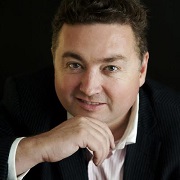When Tony McAleer became the Executive Director of Life After Hate, a nonprofit organization dedicated to rehabilitating former members of extremist movements, there was so much that needed to be accomplished. Hatred is a complicated issue, and not many people are willing to tackle the difficult task of supporting individuals who are former jihadists, gang members, or violent right-wing extremists. How could they offer solutions to the difficult problems they were facing with the people they wanted to help? What could they accomplish, given their own knowledge?
 McAleer and the founding members of Life After Hate are themselves former leaders in the American violent far-right movement – white supremacists who have been through the complex process of deradicalization, of disengaging from toxic hate. For them, leaving extremism meant finding a safe middle ground with others who could understand their experiences but who could also work with them to leave their toxic environments. By constantly reflecting on their own firsthand experiences with hate groups, Life After Hate have positioned themselves as that middle ground for individuals who want to make a better life than the ones they have built through radical hate.
McAleer and the founding members of Life After Hate are themselves former leaders in the American violent far-right movement – white supremacists who have been through the complex process of deradicalization, of disengaging from toxic hate. For them, leaving extremism meant finding a safe middle ground with others who could understand their experiences but who could also work with them to leave their toxic environments. By constantly reflecting on their own firsthand experiences with hate groups, Life After Hate have positioned themselves as that middle ground for individuals who want to make a better life than the ones they have built through radical hate.
From Storytelling to Action
Life After Hate began in 2009 as an online journal that shared stories of transformation within the American violent far-right extremist movement. Several members, all “formers” – former members of extremist groups – met for the first time at a Google Ideas Summit Against Violent Extremism (SAVE) in Dublin in 2011 and began discussing what the factors were that lead to individuals joining and leaving extremist groups. Instead of simply telling stories, how could those who had left behind a life of hate create a program of action to help others who were stuck in the abusive cycle of extremist movements? There was a very real, physical need for community outreach, but how could they use the power of storytelling to prevent hate from happening in the first place?
In 2016, five years after SAVE, the organization has been acting to recognize the sources of radicalization and to address them through research, education, outreach, and consulting. Often individuals are referred by social organizations, but sometimes they simply happen upon the online community that Life After Hate has built. This includes a private Facebook group, the Against Violent Extremism (AVE) Network, ExitUSA, and more. AVE offers the opportunity for former violent extremists and the survivors of violent extremism to situate their stories alongside one another in an attempt to change the global narrative of hatred. ExitUSA supports individuals who have made the decision to walk away from the white power movement with help from a team of formers who are there to walk individuals through their own experiences, challenges, and success.
Hate Begins with Hate and Ends with Acceptance
At the core of Life After Hate is the idea that we should never hate the individual, but instead pay attention to the context in which that individual was drawn to extremism. The organization conducts research into this fact and has gathered evidence to show that the most common reason for a person wanting to join an extremist group is childhood trauma. While nobody begins their life in extremism, “somewhere along the way, things happen to us, and we put up a shield to protect ourselves.” Individuals find what seems like structure and stability within extremist groups, but later come to realize that they are just as abusive as what they’ve experienced outside of the radicalized community. The reasons for joining are all the same: “We were seeking acceptance, approval, a sense of family, purpose, significance, power.”
The hardest part for individuals who are seeking to leave their violent communities is loneliness. “When we join extremist groups, we end up excommunicating ourselves with our friends, family, and society,” McAleer explains. “Those older networks no longer trust us. When we leave, they’re not waiting to take us back.” It takes time to earn back that trust, and in the meantime, formers exist in a void with no support system to fall back on. “That loneliness can feel more painful than the dysfunction of the place they were in,” so Life After Hate attempts to create a scaffold for those individuals to have support and yet learn the process of reclaiming their humanity.
One of the major philosophies of Life After Hate’s programming is that while the ideology and actions of hate groups are abhorrent, the individuals who exist within their structures are not. This is in part because Life After Hate is made up of those same individuals who were drawn in by the safety of white supremacy themselves. McAleer believes that the organization is uniquely positioned to support deradicalization because they “have a perspective, understanding, and credibility that someone coming from law enforcement, psychology, or social work doesn’t. Our experiences allow us to build rapport.” Their own experiences with the American violent far-right extremist movement allow for a necessary middle ground, where people who have been radicalized can discuss their feelings and concerns openly with someone who will allow to be vulnerable. McAleer believes that “this vulnerability is a really big step in being able to reconnect to society.”
Finding What Works
It has been a long journey finding out what Life After Hate is meant to do and be, McAleer says. “When I became the Executive Director, I took a hard look at what it is about us that is unique. We have this experience, and what is the most unique place to work with that experience?” After experimenting with several different methods for addressing extremism and hate, McAleer and his team adjusted their spread-out focus to hone in on outreach as the most important part of their organization. “We knew that if we stopped doing outreach in this area, then it would stop happening altogether,” he says.
Life After Hate’s success can be attributed to their unique ability to turn inward. They have recognized how their own experiences play into the work that they do, and have used that experience to carry out work that no one else can do. “We understand what we can do; at the same time, we recognize what we can’t or shouldn’t do. We have a good understanding of where our role ends.” While it may seem simple, the idea that we should work from what we know has had far-reaching impact for victims of extremism.
A former organizer for the White Aryan Resistance (WAR), Tony McAleer served as a skinhead recruiter, proprietor of Canadian Liberty Net (a computer operated voice messaging center used to disseminate messages of hatred), and manager of the racist rock band, Odin’s Law. It was love for his children that finally led Tony on a spiritual journey of personal transformation. Today he is the executive director of Life After Hate and shares his practice of compassion as an inspirational speaker.
Krystin Gollihue is a current doctoral student in the Communication, Rhetoric, & Digital Media program at NC State University.





